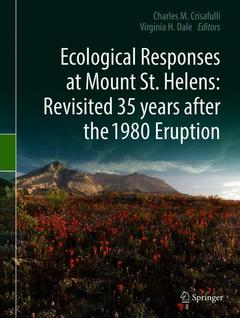Ecological Responses at Mount St. Helens: Revisited 35 years after the 1980 Eruption, Softcover reprint of the original 1st ed. 2018
Coordonnateurs : Crisafulli Charles M., Dale Virginia H.

This book builds on existing work exploring succession, disturbance ecology, and the interface between geophysical and biological systems in the aftermath of the 1980 eruptions of Mount St. Helens. The eruption was dramatic both in the spatial extent of impacts and the range of volcanic disturbance types and intensities. Complex geophysical forces created unparalleled opportunities to study initial ecological responses and long-term succession processes that occur in response to a major contemporary eruption across a great diversity of ecosystems?lowland to alpine forests, meadows, lakes, streams, and rivers. These factors make Mount St. Helens an extremely rich environment for learning about the ecology of volcanic areas and, more generally, about ecosystem response to major disturbance of many types, including land management. Lessons about ecological recovery at Mount St. Helens are shaping thought about succession, disturbance ecology, ecosystem management, and landscape ecology.
In the first five years after the eruption several syntheses documented the numerous, intensive studies of ecological recovery. The 2005 volume ?Ecological Responses to the 1980 Eruption of Mount St. Helens? (Springer Publishing) was the first ecological synthesis since 1987 of the scores of ecological studies underway in the area. More than half of the world?s published studies on plant and animal responses to volcanic eruptions have taken place at Mount St. Helens. The 25-year synthesis, which generally included investigations (i.e., data) from 1980-2000, made it possible to more thoroughly analyze initial stages of ecological responses and to test the validity of early interpretations and the duration of early phenomena. And 35 years after the eruption, it is time for many of the scientists working in the first three-decade, post-eruption period to pass the science baton to the next generation of scientists to work at Mount St. Helens, and
a synthesis at this time of transfer of responsibility to a younger cohort of scientists will be an enormous asset to the continuation of work at the volcano.Charles M. Crisafulli is a Research Ecologist with the USDA, Forest Service, Pacific Northwest Research Station. His primary research focuses on initial and longer-term ecological responses of organisms, in aquatic and terrestrial ecosystems, following explosive volcanism. From 1980 to present (2017) he has worked at Mount St. Helens and since 2008 he has annually conducted field research at several other contemporary eruption sites in Patagonia, Chile. His primary research themes are processes of succession and assembly of biological communities, and chiefly focus on small mammals, birds, amphibians and arthropods. He is currently engaged in expanding and testing the generality of lessons drawn from Mount St. Helens to volcanoes in other regions of the world such as South America, Asia, and Alaska, and more broadly to developing a global volcano ecology database to access the current state of the field and to develop science strategies for the future related to investig
ations of volcanically disturbed ecosystems.Virginia H. Dale is a Corporate Fellow at Oak Ridge National Laboratory (ORNL) in east Tennessee. She was on the first team of biologists who entered the Red Zone at Mount St. Helens after the 1980 eruption and has been studying vegetation reestablishment there ever since. Her primary research interests are disturbance ecology, plant succession, land-use change, sustainability, and environmental decision making. She has served on national scientific advisory boards for five agencies of the United States and several committees of the National Academies of Science. She was among the members of the international science community that contributed to the Intergovernmental Panel on Climate Change Scientific Assessment that in 2007 received the Nobel Peace Prize. In 2013, she was recognized with the Distinguished Landscape Ecologist award by the United States Regional Association of the International
Features authors who have studied ecological responses at Mount St. Helens since 1980
Considers both aquatic and terrestrials ecosystems, including physical conditions (geology, soils and water quality), plant recovery and reestablishment in key impact areas, and animal responses and reestablishment
Addresses general themes of recovery and resilience in each chapter
Compares the ecological responses at Mount St. Helens to other volcanoes and the anticipated future for this complex ecosystem
Date de parution : 01-2018
Ouvrage de 336 p.
21x27.9 cm
Disponible chez l'éditeur (délai d'approvisionnement : 15 jours).
Prix indicatif 94,94 €
Ajouter au panierDate de parution : 06-2019
Ouvrage de 336 p.
21x27.9 cm
Disponible chez l'éditeur (délai d'approvisionnement : 15 jours).
Prix indicatif 94,94 €
Ajouter au panierThèmes d’Ecological Responses at Mount St. Helens: Revisited 35... :
Mots-clés :
Ecological Response; Geomorphology; Soil genesis; debris; herbivory; succession
Ces ouvrages sont susceptibles de vous intéresser

The Encyclopedia of Volcanoes 173,83 €


